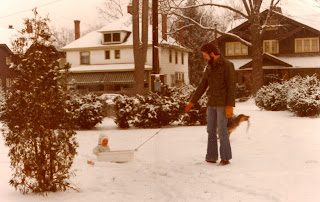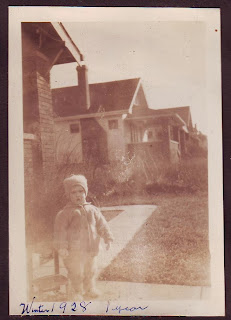Ridgeview Drive is aptly named. Lowell Avenue slightly inclines east of Arlington until it intersects with this lovely tree-lined street. North of Lowell Avenue, contractors busily constructed numerous bungalows in the 1910s and 1920s all along the drive. Rollen and Georgia Leonard moved into their home at 339 North Ridgeview Drive in the mid-1920s. Their daughter, Glenna, became the subject of numerous photographs including this one snapped in the spring of 1933. Little Glenna certainly looked dashing with her hat as she posed on that warm day. Behind her, you can see three bungalows across the street at 328, 322, and 320 North Ridgeview Drive.
In the lovely bungalow closest to Glenna, dwelled the Smith family at 328 North Ridgeview Drive. Thirty-three-year-old Charles N. worked as a superintendent for a telephone company while his thirty-four-old wife, Emily, worked as a substitute teacher. She might have been tipped off about the job from her neighbor, William R. Krickenberger, who taught math for the Indianapolis Public Schools. You will note that this bungalow today is one of the most impressively restored of its style in the entire neighborhood. This home was valued at $7,000 in 1930 and was owned by the Smiths.
Forty-seven-year-old William Roy and forty-four-year-old Katherine Krickenberger owned the brick bungalow at 322 North Ridgeview Drive. Their home was valued at $9,000 in 1930 and was one of the most expensive on the block. Mr. Krickenberger, a local math teacher, had already authored two mathematics books by 1933. In 1927, he wrote
Algebra, published the Bobbs-Merrill Company, a textbook used in high schools all over the United States. When Glenna Leonard posed for this photograph in 1933, Mr. Krickenberger had just published another work titled,
Plane Geometry (Ginn & Company). The Krickenbergers had one son, Craig, who was six years old in 1933.
The most distant home in the photo, belonged to Lawrence and Blanche Schremer, at 320 North Ridgeview Drive. The unusual bungalow still retains its interesting shape in 2013. Mr. Schremer owned a "beverage and cigar house." His business was definitely not in keeping with the accepted morals of the dry neighborhood. The young couple had no children as of 1933. Their home was valued at $7,500 in 1930.
This historic image is courtesy of Jim Brandenburg.
 |
| Glenna Leonard in 1933: Behind her you can see 328, 322, and 320 North Ridgeview Drive. |
 |
| 328, 322, and 320 North Ridgeview Drive in the autumn of 2013 |
 |
| William R. Krickenberger, of 322 North Ridgeview Drive, co-authored this book in 1927 |












+&+%3f.jpg)




.jpg)




